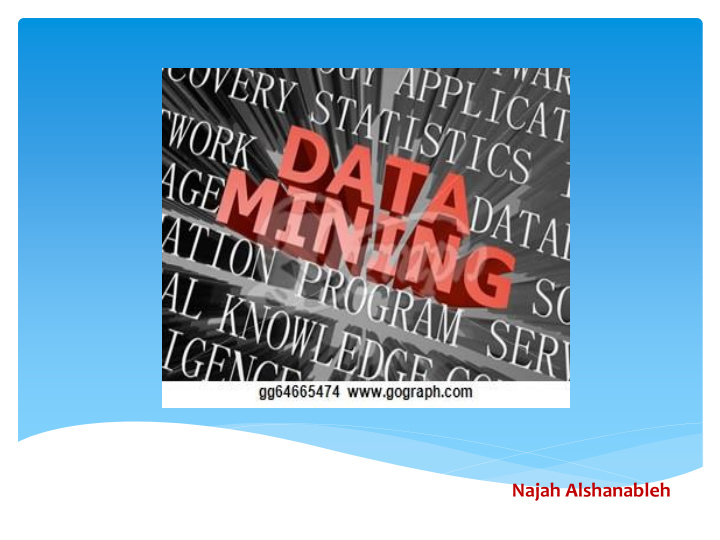



Najah Alshanableh
Agenda Important Definitions What Data Mining IS and IS NOT Steps in the Data Mining Process Examples Questions
Algorithms
Example
Translate the algorithm to a working program
Data mining definition Data mining is part of a group of concepts or techniques related to business intelligence, or e-business intelligence. Data mining involves obtaining information from a variety of sources that is stored in a data warehouse.
Data mining definition What is Data Mining? Data mining is the process of automatically discovering useful information in large data repositories.
Origins of Data Mining Draws ideas from machine learning/AI, pattern recognition, statistics, and database systems Traditional Techniques Statistics/ Machine Learning/ may be unsuitable due to AI Pattern Enormity of data Recognition High dimensionality Data Mining of data Heterogeneous, distributed nature Database of data systems
Why Mine Data? Scientific Viewpoint Traditional techniques infeasible for large data sets Data mining may help scientists in classifying and segmenting data in hypothesis formation
What is wrong with conventional statistical methods ? • Manual hypothesis testing: Not practical with large numbers of variables • User-driven … User specifies variables, functional form and type of interaction: User intervention may influence resulting models • Assumptions on linearity, probability distribution, etc. May not be valid • Datasets collected with statistical analysis in mind Not always the case in practice
Statistics vs. Data Mining : Concepts Feature Statistics Data Mining Type of Problem Well structured Unstructured / Semi-structured Inference Role Explicit inference plays No explicit inference great role in any analysis First – objective Objective of the Analysis Data rarely collected for objective of and Data Collection formulation, and then - the analysis/modeling data collection Size of data set Data set is small and Data set is large and data set is hopefully homogeneous heterogeneous Paradigm/Approach Theory-based (deductive) Synergy of theory-based and heuristic-based approaches (inductive) Signal-to-Noise Ratio STNR > 3 0 < STNR <= 3 Type of Analysis Confirmative Explorative Number of variables Small Large 14 14
Data mining is not
Data Mining is NOT Data Warehousing (Deductive) query processing SQL/ Reporting Software Agents Expert Systems Online Analytical Processing (OLAP) Statistical Analysis Tool Data visualization 16
Multidisciplinary Field Database Statistics Technology Machine Data Mining Visualization Learning Artificial Other Intelligence Disciplines 17
Results of Data Mining Include : Forecasting what may happen in the future Classifying people or things into groups by recognizing patterns Clustering people or things into groups based on their attributes Associating what events are likely to occur together Sequencing what events are likely to lead to later events
Phases in the DM Process: CRISP-DM
Data Mining Applications Pharmaceutical companies, Insurance and Health care, Medicine Drug development Identify successful medical therapies Claims analysis, fraudulent behavior Medical diagnostic tools Predict office visits 21
Examples
Questions ???
Recommend
More recommend